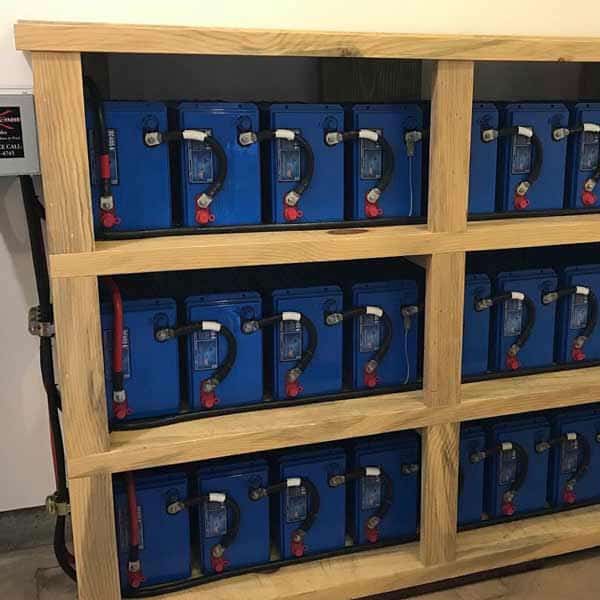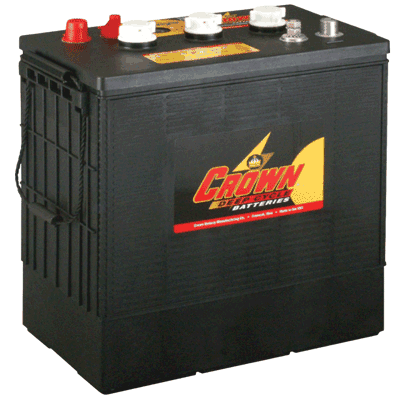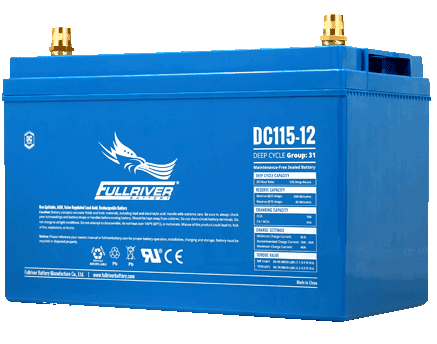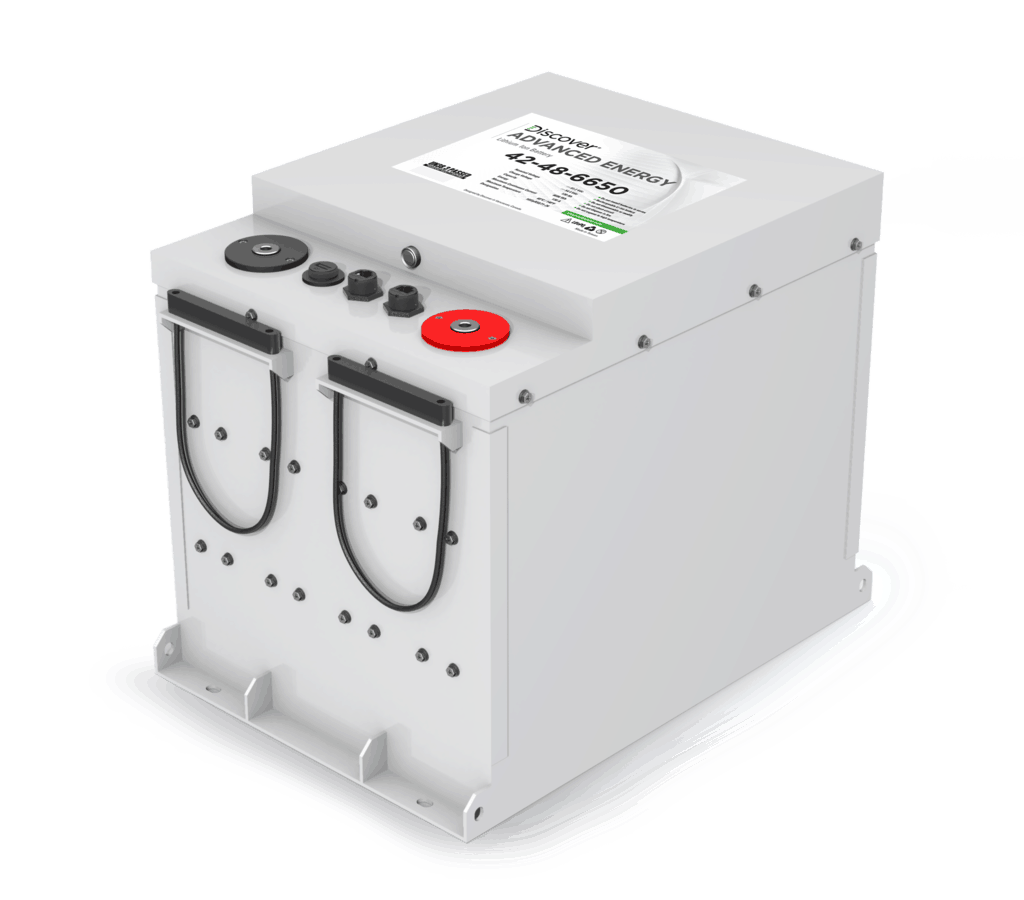Solar Battery Bank Calculator for Off-Grid
How Much Energy Storage Do You Need?
Figuring out how many batteries you need can be daunting.
If you don’t have enough battery capacity, you run out of power and you'll need to add solar battery backup and fire up the backup generator.
On the other hand, if you buy too many batteries, you add unnecessary expense to your system, with extra components, complexity and maintenance.
Sizing solar batteries is one of the first steps in designing your off-grid system.
The amount of battery storage you need is based on your energy usage. Energy usage is measured in kilowatt hours over a period of time.
For example:
1,000 watts x 10 hours per day = 10 kWh per day
Check out our off-grid load evaluation calculator.
After estimating daily usage we need to consider which type of battery will work best, as they have unique performance characteristics and are sized differently.
Sizing Your Battery Bank
The exact math for sizing your battery system is based on your daily power usage and the battery type. Based on usage of 10kWh per day, here are some examples:
Lead Acid Sizing
10kWh x 2 (for 50% depth of discharge) x 1.2 (inefficiency factor) = 24 kWh
Lithium Sizing
10kWh x 1.2 (for 80% depth of discharge) x 1.05 (inefficiency factor) = 12.6 kWh
Battery capacity is specified either in kilowatt hours, or amp hours.
For example, 24 kWh = 500 amp hours at 48 volts → 500 Ah x 48V = 24 kWh
It’s usually a good idea to round up, to help cover inverter inefficiencies, voltage drop and other losses. Think of this as the minimum battery bank size based on your typical usage. You may want to consider 600-800 amp hours of capacity, based on this example, depending on your budget and other factors.
Battery banks are typically wired for either 12 volts, 24 volts or 48 volts depending on the size of the system. Here are example battery banks for both lead acid and Lithium, based on an off-grid home using 10 kWh per day:
For Lead Acid, 24kWh is equal to:
- 2,000 amp hours at 12 volts
- 1,000 amp hours at 24 volts
- 500 amp hours at 48 volts
For Lithium, 12.6 kWh is equal to:
- 1,050 amp hours at 12 volts
- 525 amp hours at 24 volts
- 262.5 amp hours at 48 volts
Other factors influence battery sizing:
- Ambient Temperature - Heat or cold has a big impact on battery performance and capacity.
- Seasonal Factors - People use more power at different times of the year. The sun produces more power in the summer than in the winter.
- Budget - Battery bank size is often a compromise between what you want to spend on batteries and how often you'll need to run your backup generator.
How To Calculate Solar Battery Bank Size
Our solar battery bank calculator helps you determine the ideal battery bank size, watts per solar panel, and the suitable solar charge controller. If you choose to build an off-grid system, it's important to size your system based on the month with the least amount of sunlight. That way, you will have access to a sufficient amount of energy at all times. There are several steps to follow when calculating your solar battery bank. Let's review them below:
Step 1: Determine Your Daily Energy Usage
You'll want to look to your electric bill for this information. It will usually be printed as your monthly kilowatt-hour output. To calculate your daily kilowatt-hour output, you will need to divide that number by 30, then multiply by 1000 to convert the number into watt-hours. Which translates to one watt of power sustained for one hour. This is the first step in determining your solar battery bank size.
Step 2: Estimate How Many Days Your Solar System Will Be Without Sun
If you don't know this information off-hand, you can look up the annual average of cloudy days for your area online. This step is crucial in ensuring you'll have access to your solar energy year-round. A large solar battery bank size will be best utilized in areas with more cloudy days, while a smaller solar battery bank should be sufficient in areas with prevalent sunlight. However, it's always recommended to size up rather than down.
Step 3: Estimate the Lowest Temperature Your Battery Bank Will Experience
Again, you can search the average low temperature for your area online. This step will help accurately predict the adequate capacity of your battery bank.
How to Calculate Amp Hours
Calculating the amount of energy stored in a battery will use a different formula than a solar battery bank calculator. For one, you'll need information about the electric charge in the battery, also known as amp-hours.
Let's review the steps to calculating the amp hours in your battery.
Step 1: Check the Voltage
We'll use V to represent this unit. V stands for voltage of the battery. For example, a standard battery voltage is 12V.
Step 2: Determine the Amount of Energy Stored in the Battery
Let's use E to represent this unit. E represents the energy stored in a battery, which is also expressed in watt-hours.
Step 3: Input Numbers Into a Battery Amp Hour Calculator or the Formula Below
The calculator will use this formula to determine the amp hours. You can always opt to do the math yourself.
E = V * Q
Q (amp hours) = E / V
Note that the letter Q represents the battery capacity, measured in amp-hours.
Picking the Right Battery
So, which solar battery is right for you? There are a few different battery types commonly used for off-grid storage systems:
The two main battery chemistries for off-grid are Lead Acid (flooded or sealed) and Lithium. These two chemistries have unique characteristics. Lithium batteries are more efficient, which means less power is wasted in the charge/discharge process. They also have a greater discharge depth allowing you to fully utilize all of your battery capacity.
Lead acid batteries are sensitive and need to be fully recharged every day, where Lithium batteries can stay at a partial charge without any adverse effect. Lead acid batteries also have a more limited amount of usable capacity and are typically discharged only 50%.
Because of the better efficiency and deeper discharge depth, Lithium battery banks tend to be only 50-60% of the size of a comparable lead acid bank! The Lithium batteries we use are purpose-built for off-grid solar, and utilize a special Lithium chemistry called Lithium Ferro Phosphate (LiFePO4, commonly called “LFP”).
This type of Lithium battery is engineered to provide a long service life (over 10 years) while also being safe, with a stable chemistry and sophisticated electronic protection features.

Check out our complete list of battery banks. All of our battery banks include high quality, UL listed interconnect cables. Our Flooded lead acid battery banks include a refractometer for measuring battery state of charge.
We offer off-grid packages complete with solar panels, racking, cable, and a power center. Each system has several battery options and everything is sized proportionally, so the solar panels, inverter and battery all work optimally together. Here are examples of complete systems with battery banks:
| System | Solar Power | Energy Storage |
|---|---|---|
| 1.92 kW 6-Panel Heliene Off-Grid Solar System | 1.92kW Solar Array |
5.6kWh: 220ah 24v Lithium
10kWh: 415ah 24v Sealed LA 10.3kWh: 430ah 24v Flooded LA |
| 4.8 kW 15-Panel Heliene Off-Grid Solar System | 4.8kW Solar Array |
14.8kWh: 260ah 48v Lithium
20kWh: 415ah 48v Sealed LA 20.6kWh: 430ah 48v Flooded LA |
| 7.68 kW 24-Panel Heliene Off-Grid Solar System | 7.68kW Solar Array |
26.4kWh: 520ah 48v Lithium
39.8kWh: 830ah 48v Sealed LA 41.3kWh: 860ah 48v Flooded LA |
| 11.52 kW 36-Panel Heliene Off-Grid Solar System | 11.52kW Solar Array |
26.4kWh: 520ah 48v Lithium
55.2kWh: 1150ah 48v Sealed LA 57.6kWh: 1200ah 48v Flooded LA |
This is not intended to be a comprehensive guide on off-grid design.
Use this information, based on your energy usage, to get an idea of the minimum battery bank size, and then call us at 1-800-472-1142 for help picking the best solution for your needs.

Questions? Chat with us!
Wil has been a part of the solar industry for over 20 years; as an electrician, solar installer, support technician, and more. He's also been living off-grid since 1996. Wil and the rest of the Unbound Solar team are here to answer any questions you have about designing a system that will fit your needs.


